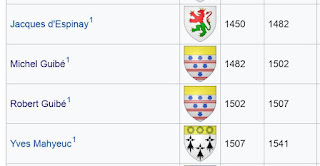In 2007, after a day in spent looking at illuminated leaves and cuttings at the Princeton Museum of Art, I walked past a general antiques shop and noticed a framed leaf of a late 15th-century French illuminated manuscript in the window.
I have not been back to the shop since then, but it looks as if one of these leaves, in its simple gold frame, was still hanging inside the window of the shop as recently as August 2017, when Google StreetView captured these images :
 |
| [source] |
 |
| Detail of the upper right corner of the left shop window [source] |
I went in and chatted to the owner, who revealed that he had a second leaf from the same manuscript, and he let me photograph them both (badly). One is shown at the top of this post; here is the other:
In December 2017 Bill Stoneman sent an email with the exciting news that several medieval illuminated manuscript leaves and cuttings had been discovered at the Houghton Library, amongst a collection of unrelated material. One of them is this:
 |
| [Houghton Library, MS Lat 470] |
The historiated initials depicts a bishop (with mitre and crozier) and introduces liturgical directions (underlined in red) which begin "Hic incipit ordo qualiter sinodus agatur ab episcopo in ecclesia redonen'. Que celebratur debet bis in anno ...". A few lines further down, after a blue paragraph mark, the text continues "Episcopus cum abbatibus solemniter indutus ...":
Thus, this is an ordo for a bishop of Rennes ("Redonen[sis]" in the rubric), in Brittany:
The underlined liturgical directions are followed immediately by a litany of saints, and this confirms the Rennes origin by its inclusion of rare saints such as Melanius (6th-century bishop of Rennes, to whom a the monastery of St-Melaine in the city is dedicated), Armagillus (6th-century founder of St Armel-des-Bocheaux, near Rennes), and Gobrianus (7th-8th-century bishop of Vannes, south-east of Rennes):
We encountered the same three saints in the calendar of a Rennes Breviary now in New York, in this post.
I find Wikipedia to be extremely unreliable for anything relating to medieval manuscripts, but it can be very useful for lists of things; in this case, a list of the bishops and archbishops of Rennes:
 |
| [source] |
 |
| [source] |
In the next post we will see what else we can find out about this manuscript, and about its owner, Michel Guibé, to whom a whole wikipedia article is dedicated.








The arms for Michel Guibé and his brother Robert in Wikipedia have the scallop shells arranged three-two-one, whereas the arms you illustrate above have them arranged three-two-three. Is this a significant difference?
ReplyDeleteI do not know, but I assume the difference is not significant, and that it is just "artistic licence"; Michel's other Pontifical-Missal (discussed next week) has the same form of the heraldry. I'd be interested if someone knows better, though.
ReplyDeleteThis comment has been removed by the author.
ReplyDeleteMon amie Diane Booton me précise, via Xavier Ferrieu (+), que les deux versions, 3,2,1 et 3,3,3 sont toutes deux utilisées par les Guibé.
ReplyDelete